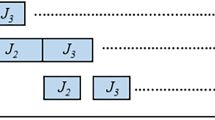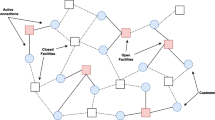Abstract
Given a set of m resources and n tasks, the dynamic capacity acquisition and assignment problem seeks a minimum cost schedule of capacity acquisitions for the resources and the assignment of resources to tasks, over a given planning horizon of T periods. This problem arises, for example, in the integrated planning of locations and capacities of distribution centers (DCs), and the assignment of customers to the DCs, in supply chain applications. We consider the dynamic capacity acquisition and assignment problem in an environment where the assignment costs and the processing requirements for the tasks are uncertain. Using a scenario based approach, we develop a stochastic integer programming model for this problem. The highly non-convex nature of this model prevents the application of standard stochastic programming decomposition algorithms. We use a recently developed decomposition based branch-and-bound strategy for the problem. Encouraging preliminary computational results are provided.
Similar content being viewed by others
References
Ahmed, S., M. Tawarmalani, and N.V. Sahinidis. (2000). “A Finite Branch-and-Bound Algorithm for Two-Stage Stochastic Integer Programs.” Stochastic Programming E-Print Series. URL: http://dochost.rz.hu-berlin.de/speps/
Berman, O., Z. Ganz, and J.M. Wagner. (1994). “A Stochastic Optimization Model for Planning Capacity Expansion in a Service Industry Under Uncertain Demand.” Naval Research Logistics 41, 545–564.
Birge, J.R. and F. Louveaux. (1997). Introduction to Stochastic Programming. New York: Springer.
Birge, J.R. and F.V. Louveaux. (1988). “A Multicut Algorithm for Two-Stage Stochastic Linear Programs.” European Journal of Operational Research 34(3), 384–392.
Blair, C.E. and R.G. Jeroslow. (1982). “The Value Function of an Integer Program.” Mathematical Programming 23, 237–273.
Caroe, C.C. (1998). “Decomposition in Stochastic Integer Programming.” Ph.D. Thesis, University of Copenhagen.
Caroe, C.C. and J. Tind. (1998). “L-Shaped Decomposition of Two-Stage Stochastic Programs with Integer Recourse.” Mathematical Programming 83, pp. 451–464.
Ermoliev, Y. (1983). “Stochastic Quasigradient Methods and Their Application to Systems Optimization.” Stochastics 9, 1–36.
Fong, C.O. and V. Srinavasan. (1981a). “The Multiregion Dynamic Capacity Expansion Problem: Part I. Operations Research 29, 787–799.
Fong, C.O. and V. Srinavasan. (1981b). “The Multiregion Dynamic Capacity Expansion Problem: Part II.” Operations Research 29, 800–816.
Higle, J.L. and S. Sen. (1991). “Stochastic Decomposition: An Algorithm for Two Stage Stochastic Linear Programs with Recourse.” Mathematics of Operations Research 16, 650–669.
Infanger, G. (1993). “Monte Carlo (Importance) Sampling Within a Benders Decomposition Algorithm for Stochastic Linear Programs.” Annals of Operations Research 39(1-4), 69–95.
Klincewicz, J.G., H. Luss, and C.-S. Yu. (1988). “A Large-Scale Multilocation Capacity Planning Model.” European Journal of Operational Research 34, 178–190.
Laporte, G. and F.V. Louveaux. (1993). “The Integer L-Shaped Method for Stochastic Integer Programs with Complete Recourse.” Operations Research Letters 13, 133–142.
Lim, S.-K. and Y.-D. Kim. (1999). “An Integrated Approach to Dynamic Plant Location and Capacity Planning.” Journal of Operational Research Society 50, 1205–1216.
Liu, M.L. and N.V. Sahinidis. (1996). “Optimization in Process Planning under Uncertainty.” Industrial and Engineering Chemistry Research 35, 4154–4165.
Norkin, V.I., G.C. Pflug, and A. Ruszczyński. (1998). “A Branch-and-Bound Method for Stochastic Global Optimization.” Mathematical Programming 83, 425–450.
Ruszczyński, A. (1986). “A Regularized Decomposition Method forMinimizing a Sum of Polyhedral Functions.” Mathematical Programming 35, 309–333.
Schultz, R. (1993). “Continuity Properties of Expectation Functions in Stochastic Integer Programming.” Mathematics of Operations Research 18(3), 578–589.
Schultz, R. (1995). “On Structure and Stability in Stochastic Programs with Random Technology Matrix and Complete Integer Recourse.” Mathematical Programming 70(1), 73–89.
Schultz, R., L. Stougie, and M.H. van der Vlerk. (1998). “Solving Stochastic Programs with Integer Recourse by Enumeration: A Framework Using Gröbner Basis Reductions.” Mathematical Programming 83, 229–252.
Shapiro, A. and Y. Wardi. (1996). “Convergence Analysis of Gradient Descent Stochastic Algorithms.” Journal of Optimization Theory and Applications 91, 439–454.
Swaminathan, J.M. (2000). “Tool Capacity Planning for Semiconductor Fabrication Facilities under Demand Uncertainty.” European Journal of Operational Research 120, 545–558.
Van Slyke, R. and R.J.-B. Wets. (1969). “L-Shaped Linear Programs with Applications to Optimal Control and Stochastic Programming.” SIAM Journal on Applied Mathematics 17, 638–663.
Author information
Authors and Affiliations
Corresponding author
Rights and permissions
About this article
Cite this article
Ahmed, S., Garcia, R. Dynamic Capacity Acquisition and Assignment under Uncertainty. Annals of Operations Research 124, 267–283 (2003). https://doi.org/10.1023/B:ANOR.0000004773.66339.df
Issue Date:
DOI: https://doi.org/10.1023/B:ANOR.0000004773.66339.df




